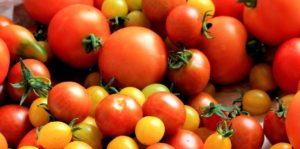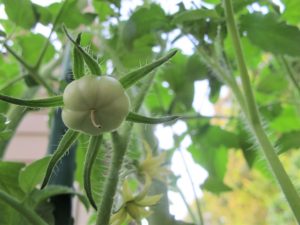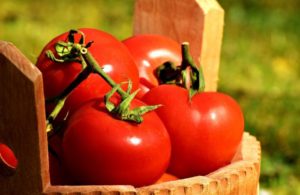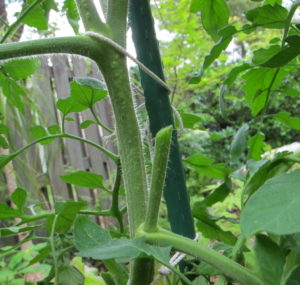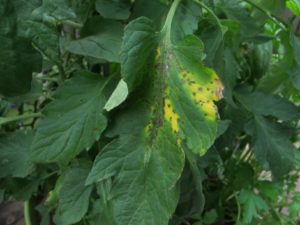A Tomato Plant For Your Garden
Anyone who has grown a tomato plant and experienced sublime sun-ripened perfection understands the joy that awaits those new to this endeavor. But it takes a little skill. Starting with light, I’ll explain the basics here. And be sure to read related posts to get the full picture.
How Much Sun For a Tomato Plant?
A tomato plant requires at least 7 hours of direct sun. Sure, many sources of information recommend 6 hours, and you’ll certainly have some success. But, for best performance, give it 7 or 8 hours or more.
Tomatoes produce more flowers in a sunnier location. And their leaves will make more “food” (carbohydrates resulting from photosynthesis) that keeps plants growing and producing. More hours of sun maintains drier foliage for a longer period of time. And drier foliage means fewer problems with disease.
Now if you don’t have a spot that gets 7 hours of sun, but it gets 5, you might be able to get fruits from a cherry tomato plant. Instead of being disappointed with the lower-yielding but yummy heirlooms or the big beefsteaks, try ‘Sun Gold’ or the other cherry tomatoes. ‘San Marzano’ and ‘Juliet’ also are worth considering for five or six hours of sun. Because they are high-yielding, you’ll probably harvest something.
But, in full sun, cherry tomatoes produce so many fruits that you’ll be giving them away by the bowlful. Really…they’ll have produced hundreds of fruits on a tall vine by the end of summer.
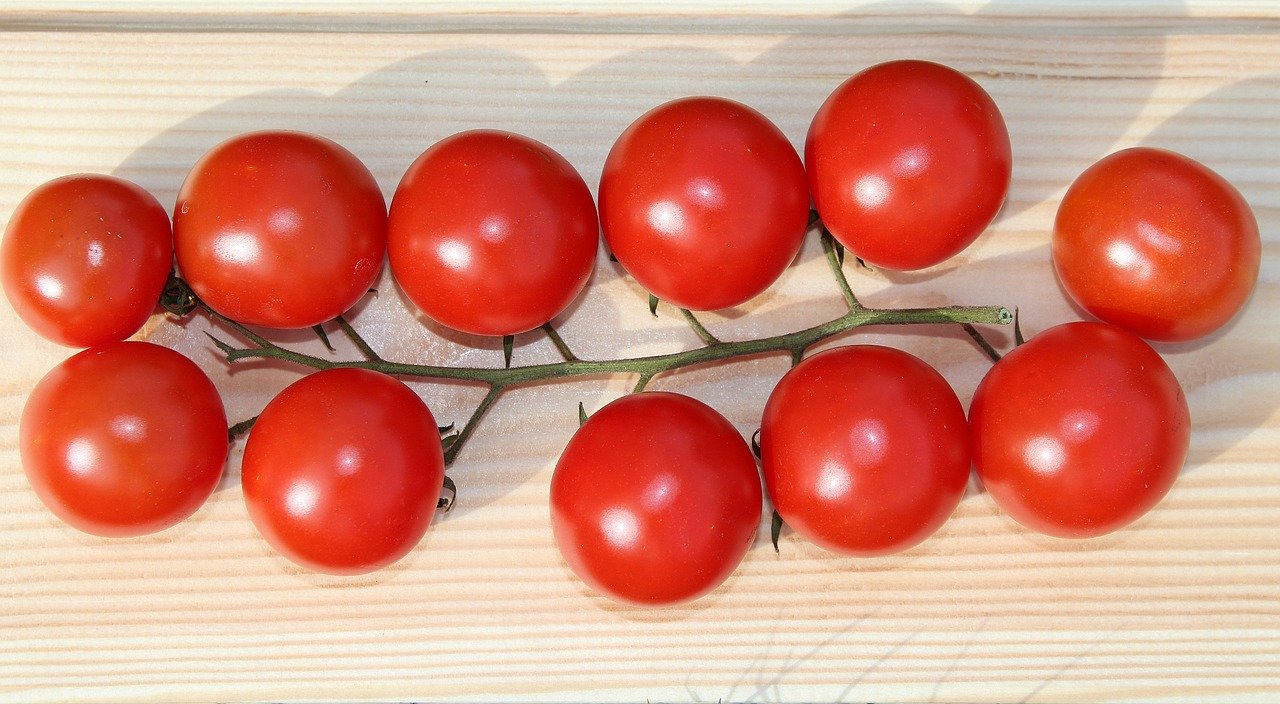
A “hand” of cherry tomatoes.
Options
If you have the space, some experimentation might yield promising results. Try growing tomatoes in large pots on the sunny patio, and plant greens where there isn’t enough sun for tomatoes. Or perhaps a corner of the sunny rose garden can be given over to edibles that need full sun, if the soil hasn’t been treated with chemicals.
I don’t often recommend cutting down trees. Removing a silver maple that seeded near the vegetable garden, however, will make the garden more productive, and, if permitted, that’s the way to go. When selecting trees for an average size property, choose small-growing trees and locate them far from gardens requiring full sun. Consider their mature size and where the shade will fall from one season to the next.
More Light For a Tomato Plant
Here are some tricks to coax more production out of your edible plants if the sun exposure is less than ideal:
- Plant in as sunny a spot as you have, perhaps near a white or light-colored wall, which will reflect more light toward the tomatoes. Or, using a little resourcefulness, create a reflective wall with tall stakes and white fabric.
- Lay repurposed light-colored empty mulch or potting soil bags on the soil, on the sunny side of the plants. Anchor them with stones or bricks. Punch lots of holes in the plastic so the plants will get enough water from rain or irrigation. Don’t allow water to collect for more than a few days or you’ll have trouble with mosquitoes.
- Porous synthetic or woven mulches are available from garden supply companies. White mulch helps reflect the light and also keeps soil cooler. Additionally, a source of light from below the plant confuses insect pests and might cause them to take up residence elsewhere.
- Use a few stakes instead of one, or a wide trellis, for a tomato plant, tying main stems farther out from the core of the plant. This will get more light onto leaves that otherwise would have been heavily shaded.
Crop Rotation
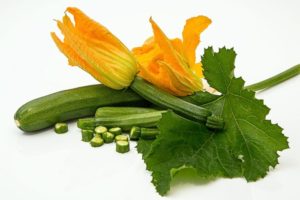
Zucchini.
If space allows, locate your tomatoes, peppers, potatoes, and eggplants (all members of the nightshade family) where none of them have been grown for the last 3 or 4 years. This crop rotation lessens the likelihood of heavy insect and disease outbreaks from one year to the next. It prevents disease spores and insect larvae from building up in the soil and infecting new foliage.
Tomatoes and other members of the nightshade family (Solanaceae) are affected by certain insects and diseases that generally do not bother other families of vegetables. Cucurbits (zucchini, cucumber, squash) and brassicas (broccoli, kale, cauliflower) have their own problems, as do the other plant families.
Disease Resistance
You’ll notice on seed packets, labels, and in catalog descriptions, a series of capital letters after the cultivar’s name. Those letters are initials for the diseases to which that cultivar is resistant. For example, ‘Big Beef’ tomato has the letters AS, F2, L, N, TMV, and V after its name. They represent the diseases Alternaria stem canker, Fusarium wilt (races 1 and 2), Grey leaf spot, Nematodes (not a disease but a tiny worm), Tobacco mosaic virus, and Verticillium wilt, respectively.
Most hybrids have been bred to withstand some disease pressure. Heirlooms are more susceptible to disease, but the flavor of their fruits is superior to that of many varieties commonly found at garden centers. If you have the space, try growing one or two heirlooms in addition to disease resistant varieties.
(***Update***: In 2019, I grew 2 heirloom tomato plants in large pots, and both succumbed to disease well before the end of the summer. We had an especially wet and humid season, but I knew the odds when I’d bought them. Still, each one produced several dozen fruits before removal.)
Susceptibility to disease varies from one area of the country to another, so you might never see some of the diseases that pop up elsewhere.
Weather plays an important role, too, and there’s nothing we can do about that. Choosing at least one disease resistant tomato plant is wise.
To a certain degree, we can manage the environment and our gardening practices in ways that discourage insects and diseases. I almost always include an heirloom tomato plant in my garden, knowing that it is more vulnerable to disease, but it’s worth the effort.
Disease Prevention For a Tomato Plant
For gardeners with limited garden space, crop rotation is not an option. In that case, consider mulching your plants with coarse, chunky material, such as pine bark mulch. Having a dry surface under the plants, as opposed to a moist surface that can harbor disease organisms, is another line of defense. Those large chunks will dry faster than the surface of clay soil or shredded hardwood mulch. Several inches of seed-free straw or dry oak leaves also work.
Porous landscape fabric is another barrier you can use. This product is available in both biodegradable and synthetic materials.
Using pine mulch or fabric will help keep dormant spores of soil-borne diseases, deposited from previous crops, from splashing up onto the low-growing foliage, infecting new plants. Always remove diseased foliage to the trash. Spores can, of course, be blown in from elsewhere, but it’s always best to exercise that ounce of prevention when we can.
Yes, problems can crop up. But usually there is enough fresh produce harvested from your own back yard to consider the garden a worthwhile project.
Air Circulation and Suckers
Air circulation around each plant is another factor in disease prevention. I plant tomatoes 4 feet apart in the garden and permit only 3 or 4 main stems to develop on each one. Some growers limit the number of stems to just 2 and space the plants closer together.
A tomato plant is a weedy thing, and, left to its own devices, will create a tangled twining mess of stems and leaves. That doesn’t mean it won’t produce fruit. However, controlling the growth improves air circulation, which keeps the foliage healthier.
As tomato plants grow, suckers grow from axillary buds in the angle between the leaf and the stem. Those suckers will grow into more main stems if not limited. Simply snip out the suckers that have been selected for removal.
Tie stems to tall, sturdy stakes to lift tall plants off the ground. Removing suckers and staking a tomato plant increases the air circulation around and through the foliage, prolonging the plant’s life.
When the plants have been established for a few weeks, and they’re growing vigorously, remove the bottom leaves to get more air circulating underneath the plants. I keep about 12″ of the stem leaf-free. Keep the foliage as dry as possible and avoid handling wet plants.
When Disease Strikes
Diseased plants will start losing foliage, generally from the bottom up. Leaves become yellow, spotted, puckered, or crispy brown. Widespread disease requires removal of the plants.
If a disease has just been noticed, though, remove to the trash all spotty, blighted leaves with clippers that have been dipped in a 10% bleach solution before going to the next plant. Disease can spread from plant to plant on infected tools and hands.
Spraying the plants with an appropriate remedy might save the plants. Several copper-, bicarbonate-, and microbe-based fungicides are available for organic growers.
Prevent the deadly tobacco mosaic virus from infecting tomatoes and peppers by never smoking near the vegetable garden, and by washing hands thoroughly before working there. Tobacco is related to tomatoes and peppers, and disease spores might be present in the product.
Occasionally we see tomato plants with leaves at the top all twisted and contorted. Sometimes they’re discolored as well. This can result from the application of herbicides, if not on your property, then from a few houses away. The chemical is carried on the breeze, and it takes minute quantities to affect tomatoes. Either cut the plants back to healthy foliage or replace with new transplants. Check also for leafhoppers and aphids inside curled leaves.
Sun Scald
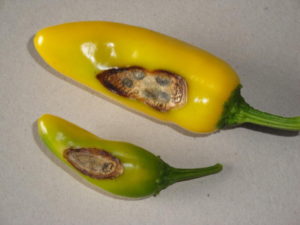
Sun scald on sweet peppers.
On Peppers
Strong sun hitting the fruits on very hot afternoons can cause sun scald. Keeping enough leaf cover will protect the fruits. Patches of sun scald are the parts of the fruit that were perpendicular to the hottest rays of the sun.
Don’t thin pepper plants; they’re especially vulnerable to sun scald. These fruits (photo, above) from a young and sparsely-leaved ‘Lemon Dream’ pepper were not adequately shaded. But the good parts don’t have to go to waste. Simply remove the affected parts.
Tomatoes Exposed To Sun
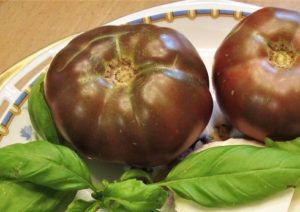
‘Cherokee Purple’ tomatoes and basil.
I prefer 3 or 4 stems on a tomato plant instead of 2; there are more leaves to lessen the sun’s intensity without entirely shading the fruits.
The flavor is more intense in some varieties (such as ‘Cherokee Purple’, ‘Black Krim’, and other “black” tomatoes) if the fruits are exposed to some direct sunlight. Morning sun is more gentle than hot afternoon sun. But on hot days, exposed tomatoes can get sun scald. Pick those tomatoes, remove the mushy parts affected by sun scald, and eat them right away, before they start rotting.
Sunlight gives fruits a richer color, increasing levels of anthocyanins. What are they? Anthocyanins, the blue and red pigments in fruits and vegetables, are powerful antioxidants, which help fight inflammation and play an important part in cancer prevention.
When you consider how much effort is required to support large amounts of ripening fruit on a mature tomato plant, it seems rational that 3 or 4 leafy stems will be able to produce a lot more “food” (carbohydrates from photosynthesis) for the developing fruits. This will help the fruits achieve full size and, more importantly, full flavor.
Headings
Page 1: It’s Time To Plant Tomatoes!, How Much Sun For a Tomato Plant? (Options), More Light For a Tomato Plant, Crop Rotation, Disease Resistance, Disease Prevention For a Tomato Plant (Air Circulation and Suckers, When Disease Strikes), and Sun Scald (On Peppers, Tomatoes Exposed To Sun)
Page 2: Time to Plant!, Plant Tomatoes Deeper, Trichomes, Stake or Cage a Tomato Plant?, And Water, and Deer
